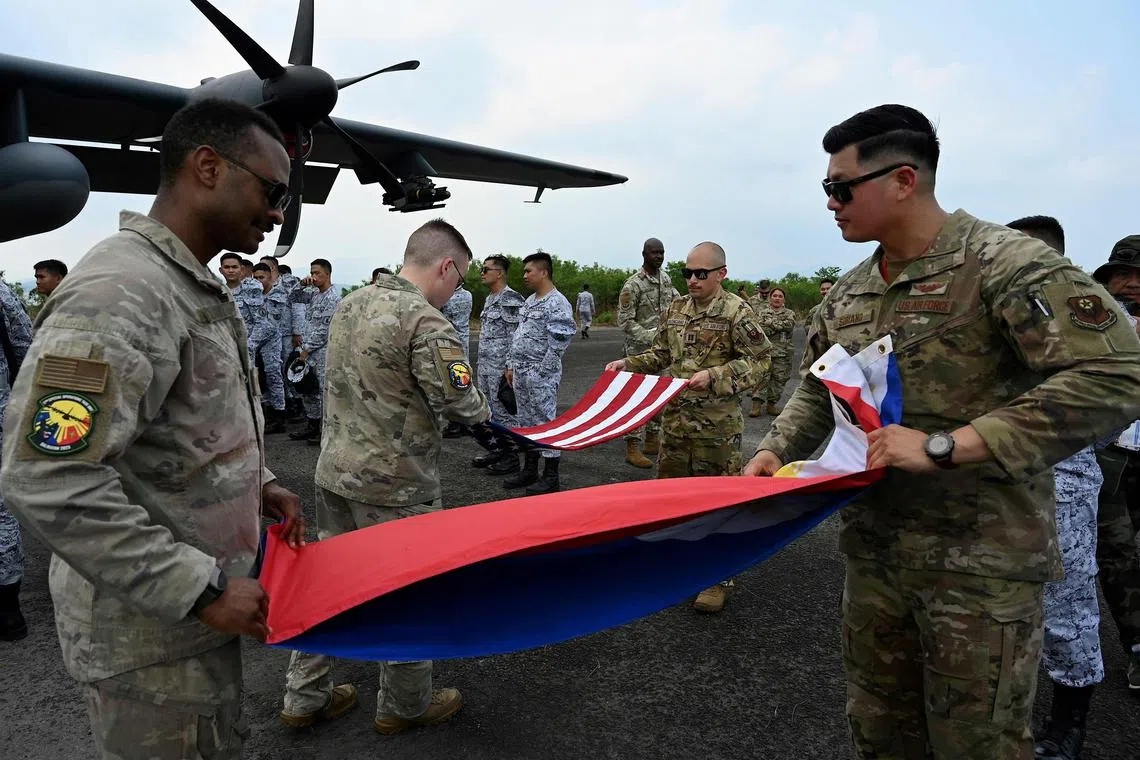Why Marcos is inviting the US military back to the Philippines
Sign up now: Get insights on Asia's fast-moving developments

In this file photo taken on April 23, US soldiers fold a US and Philippine flag at Subic Bay Freeport Zone as part of the US-Philippines joint military exercise Balikatan.
PHOTO: AFP
Follow topic:
WASHINGTON – Three decades after the United States closed its last military base in South-east Asia, the tide is turning in favour of a greater American presence in the region, spurred by mounting tensions with China. who succeeded him last year,
That is particularly evident in the Philippines, where Mr Rodrigo Duterte, the former firebrand president, had made a habit of casting doubt on the future of defence ties with the US, usually in response to what he perceived as slights or meddling in domestic affairs from Washington.
But under President Ferdinand Marcos Jr,
1. How has the tide turned?
An expansion of the Enhanced Defence Cooperation Agreement
It also allows the US to rotate its troops for prolonged stays and build new facilities on the additional bases, three of which are in the north less than 480km from the southern tip of Taiwan – the self-governing island whose future is at the centre of US-China tensions. (The fourth is in Palawan in the south, facing the South China Sea.)
The moves have not sat well with China, which has repeatedly accused the US of trying to “encircle and contain” it.
2. What’s the impetus?
US President Joe Biden, concerned about China’s growing military power, has sought to reshape the US force presence in the Indo-Pacific region. That includes restoring the relationship with the Philippines since Mr Marcos – the son of the late dictator and stalwart US ally – succeeded Mr Duterte. about Beijing’s increasingly assertive claims to a wide swath of the South China Sea,
Both countries are worried
Mr Marcos raised the issues during his meeting with China’s President Xi Jinping in January, but such provocative actions have continued. Just before meeting Mr Marcos in April, China’s Foreign Minister Qin Gang said the two countries should promote peace and stability “amid the ‘fluid’ and turbulent regional situation”.
3. What’s the history?
Spain ceded its long-held colony of the Philippines to the US after losing the Spanish-American War of 1898. The US ruled the archipelago as a territory until granting it independence in 1946, after World War II.
Clark Air Base and Subic Bay naval base, both near Manila, remained the US military outposts in the Western Pacific, however, under a 1947 agreement. Originally set to last for 99 years, that deal was revised several times as the Philippines periodically reassessed the relationship.
An amendment was added that allowed for the agreement to end in 1991. As that deadline approached, leaders from both countries sought to extend the pact. Yet an upswell of anti-colonial sentiment prompted the Philippine Senate to reject a new agreement, and the US closed the bases.
The two countries remain formal allies, however, under a 1951 Mutual Defence Treaty and have continued to conduct annual military exercises.
4. How has the relationship evolved?
Mr Duterte came into office in 2016 pledging to pivot Philippine foreign policy toward China and away from the US.
He questioned whether the US would really honour its treaty obligations to defend the Philippines if China were to seize disputed shoals and reefs in the South China Sea. He also said military deals with the US have not addressed security threats the country faces, particularly a small-scale Maoist insurgency that has dragged on for decades.
Mr Duterte moved to terminate a 1998 agreement allowing US military personnel to operate in the Philippines – then stayed the order – and frequently lashed out at the US over what he perceived as its hypocrisy and meddling on human rights in such areas as his war on drugs, which resulted in thousands of extrajudicial killings.
Yet as his term wound down, promises of big-ticket projects and billions of dollars in investments from China were largely unfulfilled, while tensions over the South China Sea flared again.
5. How else is the US adjusting its military posture in the region?
The “island chain” strategy stems from early in the Cold War era, when the US sought a string of bases in the western Pacific to contain the Soviet Union and China. That strategy lives on. US and the Philippines held their largest joint military exercises in decades
In April, the
The US plans to move thousands of Marines based in Japan to a reactivated facility in Guam, a shift also seen as part of a wider effort to better disperse American forces to confront China in case of a crisis.
It also has been seeking to build influence among island nations in the southern Pacific, especially since the Solomon Islands signed a security accord with Beijing last year.
And the US will provide a fleet of nuclear-powered submarines to Australia over 30 years under the Aukus partnership with Britain, which is also designed to counter China’s military expansion in the Indo-Pacific region. BLOOMBERG

